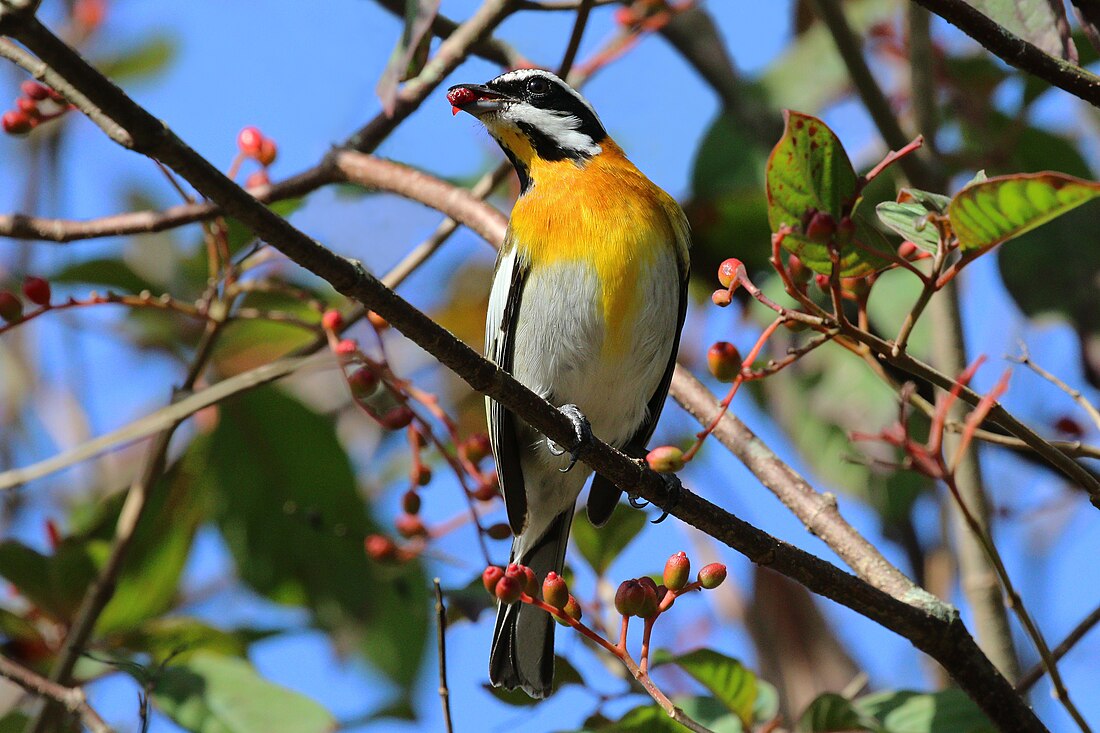Spindalis
Genus of birds From Wikipedia, the free encyclopedia
Spindalis is a genus consisting of four non-migratory species of bird. It is the only genus in the family Spindalidae. The species are mostly endemic to the West Indies; exceptions include populations of western spindalises on Cozumel Island, off the Yucatán Peninsula's east coast, and in extreme southeastern Florida. The species were traditionally considered aberrant members of the tanager family Thraupidae. Taxonomic studies recover them as a sister group to the Puerto Rican tanager (family Nesospingidae), and some group Spindalidae and Nesospingidae within the Phaenicophilidae.[2]
| Spindalis | |
|---|---|
 | |
| Western spindalis (Spindalis zena) | |
| Scientific classification | |
| Domain: | Eukaryota |
| Kingdom: | Animalia |
| Phylum: | Chordata |
| Class: | Aves |
| Order: | Passeriformes |
| Superfamily: | Emberizoidea |
| Family: | Spindalidae Barker, Burns, Klicka, Lanyon, & Lovette, 2013[1] |
| Genus: | Spindalis Jardine & Selby, 1837 |
| Type species | |
| Spindalis bilineatus Jardine & Selby, 1837=Tanagra nigricephala Jameson, 1835 Jamaican spindalis | |
Males are characterized by bright plumage while females are duller and have a different coloration. The nests are cup-shaped.[3]
Taxonomy
Summarize
Perspective
The genus Spindalis was introduced in 1837 by the naturalists William Jardine and Prideaux John Selby to accommodate a single species, Spindalis bilineatus Jardine and Selby. This name is now considered a junior synonym of Tanagra nigricephala Jameson, 1835, the Jamaican spindalis, which becomes the type species by monotypy.[4][5]
The genus contains four species:[6]
| Common name | Scientific name and subspecies | Range | Size and ecology | IUCN status and estimated population |
|---|---|---|---|---|
| Hispaniolan spindalis | Spindalis dominicensis (Bryant, H, 1867) |
Hispaniola (Haiti and the Dominican Republic) |
Size: Habitat: Diet: |
LC
|
| Jamaican spindalis | Spindalis nigricephala (Jameson, 1835) |
Jamaica |
Size: Habitat: Diet: |
LC
|
| Puerto Rican spindalis | Spindalis portoricensis (Bryant, H, 1866) |
Puerto Rico |
Size: Habitat: Diet: |
LC
|
| Western spindalis | Spindalis zena (Linnaeus, 1758) Five subspecies
|
southeastern Florida and the western Caribbean (Cozumel, the Cayman Islands, Cuba, the Bahamas and the Turks and Caicos Islands) |
Size: Habitat: Diet: |
LC
|
Taxonomy
Historically, the genus consisted of a single polytypic species, Spindalis zena (with the common name of stripe-headed tanager), with eight recognized subspecies—S. z. townsendi and S. z. zena from the Bahamas, S. z. pretrei from Cuba, S. z. salvini from Grand Cayman, S. z. dominicensis from Hispaniola and Gonâve Island, S. z. portoricensis from Puerto Rico, S. z. nigreciphala from Jamaica, and S. z. benedicti from Cozumel Island. In 1997, based primarily on morphological and vocalization differences, three of the subspecies (portoricensis, dominicensis and nigricephala) were elevated to species status. S. zena remained a polytypic species with five recognized subspecies—S. z. pretrei, S. z. salvini, S. z. benedicti, S. z. townsendi, and S. z. zena.[7]
References
Sources
Wikiwand - on
Seamless Wikipedia browsing. On steroids.







